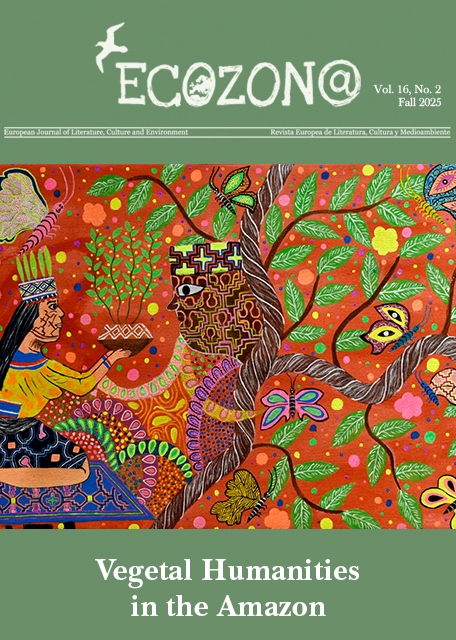<b>Talking Animals “Talking” with Animals in Elsa Morante’s <i>La Storia</i></b> // Animales hablantes que “hablan” con otros animales en <i>La Historia</i> de Elsa Morante
DOI :
https://doi.org/10.37536/ECOZONA.2016.7.1.978Mots-clés :
Semiotics, zoosemiotics, Italian, Morante, animal, communication // Semiótica, zoosemiótica, comunicación.Résumé
In this essay, I explore the representations of spoken language by animals in La Storia by Elsa Morante. Furthermore, I seek to examine the ways in which humans, namely little Useppe, express themselves with animals and interpret what is said, but I also seek to discover what elements may predispose Useppe to be privy to code-sharing with these creatures of other species. While the interactions in this tragic novel are mainly between humans, it is worthwhile to consider the relationship between Useppe and birds, canines, equines, and felines. He acts as a type of intermediary between the species, though I venture to say that he shares more in common with animals than with humans: “Useppe rimaneva del tutto estraneo, e inconsapevole, come un cucciolo ingabbiato in una fiera” (Morante 458; “Useppe remained completely estranged, and unaware, like a puppy caged and put on display” [translation my own]), like a child raised amongst wolves. Since my research examines interspecies communication, I have used zoosemiotics as a starting point. My main focus, then, will be on how Morante successfully employs zoosemiotic notions to make the “spoken” as well as gesticulative communication of the animal reflect the animal’s temperament and emotional nature—even as a synecdoche for the archetype of the animal proper—and interpretable by the human interlocutor. That is, through implicit knowledge of zoosemiotics, these symbols are not just interpreted by Useppe but answered using a mutually decipherable code. In this way, Morante illuminates the profound relationships between humans and animals, relationships that are sustained due to the myriad means by which interspecies communication, compassion, and cooperation intersect and flourish in this novel.
Resumen
En este artículo, exploro las representaciones del lenguaje hablado por los animales en La historia de la escritora italiana Elsa Morante. Además, quiero examinar los modos en los que los humanos, el niño Useppe en particular, se expresan con los animales e interpretan lo que estos últimos les dicen, pero quiero también descubrir qué elementos hacen que Useppe esté predispuesto a poder compartir códigos con criaturas de otra especie. Mientras que las interacciones en esta novela trágica son, en la mayor parte, entre humanos, es importante considerar las relaciones entre Useppe y algunos pájaros, caninos, equinos y felinos. Él actúa como una especie de intermediario entre las especies, aunque me aventuro a plantear que tiene más en común con los animales que no con los seres humanos: “Useppe rimaneva del tutto estraneo, e inconsapevole, come un cucciolo ingabbiato in una fiera” (Morante 458; “Useppe permanecía completamente extraño, e ignorante, como un cachorro enjaulado en una exposición” [traducción mía]), como un niño que fue criado por lobos. Ya que mis investigaciones examinan la comunicación interespecie, utilicé la zoosemiótica como punto de partida. Me concentro, entonces, en la manera en que Morante emplea con éxito unas nociones zoosemióticas para que lo que “dicen” los animales, tanto como con la voz como con las acciones, refleje el temperamento y la naturaleza emocional de estos—incluso como una sinécdoque del arquetipo del animal propio—y hace que el humano pueda interpretarlos. Es decir, a través de conocimientos implícitos de la zoosemiótica, Useppe no solamente interpreta estos símbolos sino que responde con un código descifrable por él y los animales con los cuales se comunica. De este modo, Morante ilumina las relaciones profundas entre humanos y animales, relaciones que se sostienen a causa de los medios con los cuales la comunicación, la compasión y la cooperación entre especie se entrecruzan y florecen en la novela.
Téléchargements
Téléchargements
Publié-e
Numéro
Rubrique
Licence
Authors who publish with this journal agree to the following terms:
a) Authors retain copyright and grant the journal right of first publication with the work simultaneously licensed under a Creative Commons Attribution License that allows others to share the work with an acknowledgement of the work's authorship and initial publication in this journal (CC BY-NC for articles and CC BY-NC-ND for creative work, unless author requests otherwise.
b) Authors are able to enter into separate, additional contractual arrangements for the non-exclusive distribution of the journal's published version of the work (e.g., post it to an institutional repository or publish it in a book), with an acknowledgement of its initial publication in this journal.
c) Authors are permitted and encouraged to post their work online (e.g., in institutional repositories or on their website) prior to and during the submission process, as it can lead to productive exchanges, as well as earlier and greater citation of published work (See The Effect of Open Access).










